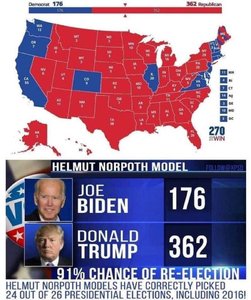Synes du staten bør bestemme hva private selskap som Twitter, Facebook og Google skal vidreformidle? Høres nesten litt kommunistisk ut eller?
Mye å ta tak i for å få mer freedom of speech. Får håpe Trump får en periode til for å røske opp i dritten
Politikk, religion og samfunn President Donald J. Trump - Quo vadis? (Del 2)
- Trådstarter Høvdingen
- Startdato
Diskusjonstråd Se tråd i gallerivisning
-
Meanwhile....
Sist redigert:
Å lure religiøse er det enkleste i verden! Bare snakk med utestemme og ha bibelen i hånden, så tror de på alt du sier. Dette har Trump skjønt og han bruker det for alt det er verdt! L. Ron Hubbard skjønte det også. At hans disipler ikke klarer å se sammenhengen mellom hans science fiction forfatterskap og det tullet han har funnet opp er hysterisk morsomt!Rune S og hans like bør vokte seg for falske profeter. Jeg mener bestemt det står noen velvalgte ord i boken hans om å falle for sånne. Eksempel:Jeg liker ikke å kalle folk dumme, men når noe kvakker....
Se fra 2.00 og ca. 20 sek.
Klepper: You are pro-life?
Minion: Of course
Klepper: So it's important for Americans to do whatever they can to protech the human life?
Minion: Of course!
Klepper: So, why aren't you wearing a mask?
Minion: Eh......I mean....it's a personal choice....
ARGH!!!!!!
De er så totalt blottet for logiske tanker at det gjør vondt!Sist redigert:
Nå er vel ikke scientologi akkurat religion, men definisjonen er flytende. Har noen lest historien bak Mormons bok, den er hysterisk morsom og nesten enda verre. " I motsetning til Bibelen, som inneholder referanser til enkelte faktiske historiske hendelser, anser ikke historikere, arkeologer og andre eksperter innen relevante fagfelt fortellingene i Mormons bok som virkelige.[4] The Smithsonian Institute i New York ser ikke på Mormons Bok som et historisk dokument og mener boken er ren fiksjon."Å lure religiøse er det enkleste i verden! Bare snakk med utestemme og ha bibelen i hånden, så tror de på alt du sier. Dette har Trump skjønt og han bruker det for alt det er verdt! L. Ron Hubbard skjønte det også. At hans disipler ikke klarer å se sammenhengen mellom hans science fiction forfatterskap og det tullet han har funnet opp er hysterisk morsomt!
US election: Rudy Giuliani's daughter endorses Joe Biden
‘I’ve come to realize that none of us can afford to be silent right now,’ former New York mayor’s daughter writes in Vanity Fairwww.theguardian.com

Rudy Giuliani Is My Father. Please, Everyone, Vote for Joe Biden and Kamala Harris.
I may not be able to change my father’s mind, but together, we can vote this toxic administration out of office.www.vanityfair.com
Blir spennende å følge Texas

Texas nears 2 million ballots cast as early voting surge continues
The 2020 presidential election is expected to be one of the highest turnout elections in...www.houstonchronicle.com
Hvis opptellingen på valgnatten viser at Biden har vunnet Texas er det bare for DJT å ringe sin gode venn Vladimir og diskutere hvor mye han vil ha i husleie. Enormt mange valgmannsstemmer, ingen vits i å klage om poststemmer etc, ingen langvarig opptelling i ukene etter valget, ingen ifs and buts. Game over.
Trump leder med ca 1,5 % i gjennomsnittet av meningsmålinger for Texas, men det er godt innenfor feilmarginene.

‘You can win this!’: how Beto O'Rourke is becoming Joe Biden’s greatest ally
The El Paso politician is on a mission to take back Texas for the Democrats, urging Biden’s team to court the state’s many undecided voterswww.theguardian.com
Sist redigert:Republikanerne har en del utsatte senatseter i år og nå er senatorene i gang med å lage godt med dagslys mellom seg og Trump.
Ben Sasse fra Nebraska har definitivt "jumped ship".
^
det er å håpe at folk gjennomskuer hykleriet og falskheten. de hører hjemme i den politiske fraukjeller!^^ Sounds about right:
Det er fristende å si "we told you so". Litt sent å fatte poenget først to uker før valget.In a dire, nine-minute indictment of Mr. Trump’s foreign policy and what Mr. Sasse called his “deficient” values, the senator said the president had mistreated women and alienated important allies around the globe, been a profligate spender, ignored human rights and treated the pandemic like a “P.R. crisis.” He predicted that a loss by Mr. Trump on Election Day, less than three weeks away, “looks likely,” and said that Republicans would face steep repercussions for having backed him so staunchly over four tumultuous years.
“The debate is not going to be, ‘Ben Sasse, why were you so mean to Donald Trump?’” Mr. Sasse said, according to audio obtained by The Washington Examiner and authenticated by The New York Times. “It’s going to be, ‘What the heck were any of us thinking, that selling a TV-obsessed, narcissistic individual to the American people was a good idea?’”
“We are staring down the barrel of a blue tsunami,” he added.Gjør han? Hvordan kommer du frem til den prognosen?
blir feil. de har ikke vært i uvitenhet om noe som helst. det er intet nytt å fatte.^^ Sounds about right:
Det er fristende å si "we told you so". Litt sent å fatte poenget først to uker før valget.
he heMisantropi.
fascister spiller ikke legalitetsspillet.
religiøse er hardnakkete misantroper. derfor hevder de at lykken er et annet sted, forvaltet av gud, og her nede bare er en jammerdal.Misantropi.
så har du misantropene som ikke har plass til gud; de kjemper en hard kamp.
filantropene er som vi vet bare bløffmakere, eller folk med synapsedefekt.
endelig er det helg, og jeg kan ta fri fra jobben (aka tenkingen).her har vi et eksempel på medias hykleri. det lå da i dagen lenge før i dag.
^Det har vel ikke NYT lagt spesielt mye skjul på siden dagen da Trump kom ned den forgylte rulletrappen sin og forkynte sitt kandidatur. "The Failing New York Times" og deres "FAKE News!!!" har vært til mye irritasjon for Trump etter tweetingen hans å dømme. Ser ikke helt hykleriet i at de gjentar det nå.
Enig, han vinner valget fordi han har levert på det han har lovet de kristne; flyttet ambassaden til Jerusalem, har fått inn konservative kristne dommere i høyesterett, byttet ut over 300 føderale dommere, de sitter på livstid og er stort sett konservative hvite menn.samtidig, når Trump allikevel vinner valget (eller, ihvertfall ikke taper), hva har man oppnådd da?
I tillegg har han levert på å fornekte kiima- og miljøtrusselen.
Kullindustrien ba Trump fjerne miljølover som begrenset utvinningen, det har han gjort.De siste fire årene har Trump-administrasjonen reversert en rekke miljølover, noe som vil få store konsekvenser for USA i lang tid fremover. – Han har gitt tillatelse til utbygging av rørledninger for olje og gass, han har fjernet restriksjoner for minedrift og tømmerhugst i føderale skoger, og han har fjernet beskyttelsen for viltreservatet i Alaska og åpnet det for oljeboring..
"Krigen" mot Kina er også viktig.....Sist redigert:Yap.
1: Primatene elsker det.
2: Og de har stemmerett, og ser at de er nødt til å bruke den, for å sørge for at GresskarJesus fremdeles får være president fire år til.
3: De er mange. Veldig mange.Omtrent hvor i meningsmålingene ser dere den effekten? Biden leder selv i Georgia og er innenfor feilmarginen i Texas, for svingende. Nasjonalt leder han med 10,5 %, og det forspranget stiger fortsatt. Han er godt over 50 %, så det holder ikke engang å få velgere "på gjerdet" til å støtte Trump (som de gjorde i 2016-innspurten), men han må aktivt få mer enn 10 % av de som sier at de har bestemt seg for Biden til å bytte side. Hva må man tro på for å tro at det skjer de neste to ukene?
I kapitlet for Oooh, this gonna hurt: Biden fikk fler seere enn Trump-sirkuset i går kveld. Low ratings! Low ratings! På tide å kansellere neste sesong av Trump. Folk er mer interessert i å høre hva den neste presidenten har å si enn å bli underholdt av outrageousness fra et orangemalt nek.

More people watched Biden on ABC than Trump on NBC, MSNBC and CNBC
Joe Biden's town hall on ABC averaged 14.1 million viewers on Thursday night, easily surpassing the Nielsen ratings for President Trump's town hall on NBC. edition.cnn.com
Sist redigert:
edition.cnn.com
Sist redigert:
Noen er. Du finner dagens odds her:Så er noen villige til å ta veddemålet om at det fremdeles ikke er noen ny president i USA 1. februar 2021?

RealClearPolitics - Betting Odds - 2020 U.S. President
RealClearPolitics - Betting Odds - 2020 U.S. Presidentwww.realclearpolitics.com
om nå biden skulle inn, noe jeg ikke tror før jeg ser det, så gjenstår borgerkrigen blant demokratene. muligens er gop allerede splittet i de som er gop og de frafalne, men hva skjer med demokratene?
la oss håpe de vettuge vinner frem. go aoc!

AOC, House progressives warn Biden on corporate hires
A letter from left-wing lawmakers and groups calls for corporate lobbyists and high-ranking executives to be shut out of a Biden administration. www.politico.com
www.politico.com
Hmm... godt poeng.religiøse er hardnakkete misantroper. derfor hevder de at lykken er et annet sted, forvaltet av gud, og her nede bare er en jammerdal.
......
Nestekjærlighet er jo et stort poeng for de kristne; men man kan vel argumentere for at den er motivert ut i fra
1: generell misantropi - folk flest er fortapt og bare min overbevisning kan redde dem
2: ren egoisme - hvis jeg redder denne stakkarslige sjelen fra fortapelse får jeg en høyere status hos min Gud.
Religion i en ren form er helt ok, og kan sikkert være til hjelp i dagliglivet,
misjonering basert på sjølgodhet begrunnet i et misantropisk menneskesyn er det store problemet.CCyber
Gjest
En viss selvsikkerhet må det ligge i bunn der, men det som fremstår verst er egosentrismen. Han snakker jo bare om seg selv og navnet sitt i sykelig omfang. Polariserende ytringer og raljering. Han sier hva som helst uten å bry seg om det er sant eller ikke.Ok,det visste jeg ikke. Viss Trump har lovt det så vil jeg kalle det en løgn viss han ikke gjør det.
Men slik jeg tolker det har han hatt ekstremt mange jern i ilden,så kanskje ting ikke er klart viss han krangler med IRS om diverse uklarheter?
Gode spørsmål. Jeg aner ikke,og viss advokater fortsatt klangler om hva er rett og galt i diverse saker han har gående,så vil det vere vanskelig for meg å si hva som er fasit.
Fyren er virkelig ikke A4. Han fremstår utad som å ha et veldig stort ego som du sier. Er ikke så helt sikker på om han er så selvsikker som han gir inntrykk av.
Man må av og til rekalibrere hjernen etter 4 år med den utrolig slitsomme masingen fra mannen. Det er ganske vilt å se klipp med Obama etter å ha sett klipp med DT:
“I am positive that if I’m lucky enough to live to a ripe old age and I’m on my deathbed and I’m thinking back on my life, I won’t be remembering some speech I gave or some law I signed, I’ll be remembering holding hands with one of my daughters and walking them to a park. That’ll be the thing most precious to me.”Sist redigert av en moderator:At that point, Trump has three ways to try to overturn the election. He will likely use them all.
Way One: All of the suits eventually end up at the Supreme Court, which does a repeat of Bush v. Gore, state by state, basically calling winners. There will only be six or seven of these that matter—Pennsylvania, Florida, North Carolina, Wisconsin, Michigan, Arizona, and maybe Ohio if Biden wins in a blowout.
Had Ruth Bader Ginsburg lived another three months, Chief Justice John Roberts might well have sided with the Court’s four liberals, and refused to allow Trump to win a second term in a coup. Now, Roberts will have to bring along one or more of the Trump appointees—either Neil Gorsuch, something of a Court institutionalist, or Brett Kavanaugh, or that pretend blank slate, Amy Coney Barrett. A long shot, perhaps, but not impossible.
Way Two: Trump’s allies in state legislatures reverse the popular result and file competing slates of electors. Unless Democrats flip House majorities in three states in the incoming Congress, the House presumably votes for the Republican electors.
Way Three: Violence. Regardless of the outcome, there will be millions of people protesting in the streets. Most of those inclined to violence will be from the Trumpian right, though a few far-lefties may add to the chaos. All of this gives Trump a pretext to invoke the Insurrection Act and call in the military.
Takeaways: Trump can continue making a fool of himself, and Biden could win all of the swing states on Election Day; but we still can’t rest easy until January 20. Yet the bigger the win, the less likely it is to be overturned. I sure wish this were all safely in the history books instead of unfolding insanely day by day.
 ^ Det er langt mer sannsynlig enn at det liksom skulle være et flertall som stemmer på Trump i takknemlighet for alt han har utrettet. Meningsmålingene viser såpass stor ledelse for Biden at et Trump-vennlig flertall ikke ser ut til å finnes. Dessuten har meningsmålerne oppdatert alle vektinger for å unngå 2016 om igjen, f eks med å vekte mer etter utdannelsesnivå, så det er mer sannsynlig at eventuelle feil i meningsmålingene nå går i Trumps favør enn motsatt. Spørsmålet er heller om det finnes måter han kan stjele valget på selv om han taper med med 10-15 prosentpoeng. At han kommer til å forsøke med alle midler er opplagt.Var flere som fulgte Bidens Town Hall enn Trumps ... Borte på Free Republic tror de på julenissen. Dvs. denne "spådommen" er laget for å underbygge påstander om at "the election was stolen".
^ Det er langt mer sannsynlig enn at det liksom skulle være et flertall som stemmer på Trump i takknemlighet for alt han har utrettet. Meningsmålingene viser såpass stor ledelse for Biden at et Trump-vennlig flertall ikke ser ut til å finnes. Dessuten har meningsmålerne oppdatert alle vektinger for å unngå 2016 om igjen, f eks med å vekte mer etter utdannelsesnivå, så det er mer sannsynlig at eventuelle feil i meningsmålingene nå går i Trumps favør enn motsatt. Spørsmålet er heller om det finnes måter han kan stjele valget på selv om han taper med med 10-15 prosentpoeng. At han kommer til å forsøke med alle midler er opplagt.Var flere som fulgte Bidens Town Hall enn Trumps ... Borte på Free Republic tror de på julenissen. Dvs. denne "spådommen" er laget for å underbygge påstander om at "the election was stolen".
Når resultatet blir omtrent det motsatte vil slikt bli brukt for å komme med anklager om "election fraud" ... (og, ja, fri fantasi. NY som republikansk er hinsides, blant mye som er hinsides).
Republikanerne forsvarer 23 seter i Senatet i år, mens demokratene forsvarer 12. Avhopperne som nå går ut og kritiserer Trump gjør det fordi de ser hvor dette bærer.
 Sist redigert:Det kan hende at de gjør det. Statene på østkysten vil offentliggjøre resultater før valglokalene har stengt i vest. Trump-velgerne har blitt tutet ørene fulle av at poststemmer er juks og om at de må møte opp på selve valgdagen for å sikre at alt går rett for seg. Det er et mulig scenario at stater som Pennsylvania og Georgia offentliggjør resultater med solid ledelse for Biden, og at trumpistene vestover i stedet tenker «why bother...» Det kan påvirke senatsvalget en hel del om noe slikt skjer.
Sist redigert:Det kan hende at de gjør det. Statene på østkysten vil offentliggjøre resultater før valglokalene har stengt i vest. Trump-velgerne har blitt tutet ørene fulle av at poststemmer er juks og om at de må møte opp på selve valgdagen for å sikre at alt går rett for seg. Det er et mulig scenario at stater som Pennsylvania og Georgia offentliggjør resultater med solid ledelse for Biden, og at trumpistene vestover i stedet tenker «why bother...» Det kan påvirke senatsvalget en hel del om noe slikt skjer.
Hvordan Free Republic/Helmuth Norpoth (som jeg aldri har hørt om) kommer frem til en slik prognose er ikke godt å si. Den er ihvertfall ikke basert på reelle meningsmålinger.

2020 Election Forecast
Latest forecast of the 2020 presidential election between President Donald Trump and Joe Biden by Nate Silver’s FiveThirtyEightprojects.fivethirtyeight.com
-
Laster inn…
Diskusjonstråd Se tråd i gallerivisning
-
-
Laster inn…






